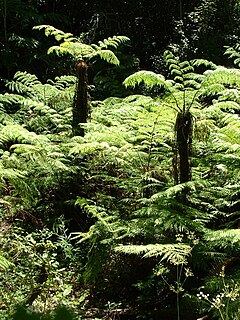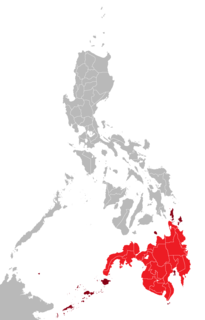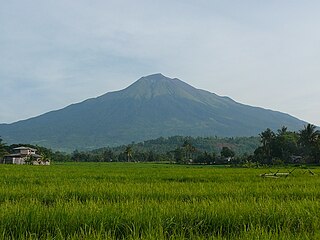Cyathea acuminata is a species of tree fern native to the islands of Panay and Samar in the Philippines. The trunk is erect and 1–4 m tall or more. Fronds are bi- or tripinnate and about 1 m in length. The stipe is covered with scattered scales and spines. The scales are flat and dull brown in colour. Sori are present near the midvein of fertile pinnules and are covered by firm indusia.
Cyathea approximata is a species of tree fern endemic to Madagascar. The trunk is erect, spiny and about 2 m tall. Fronds are bipinnate and usually 2 m long. They often form a crown of two whorls of about seven fronds each. Dark brown scales with a paler margin cover the stipe. Sori are round and occur near the fertile pinnule midvein. They are covered by thin, brown indusia, which are cup-like in appearance.
Cyathea atropurpurea is a species of tree fern native to the islands of Luzon, Mindanao, Leyte and Mindanao in the Philippines, where it grows in forest at above 1000 m. The erect trunk is slender and may be up to 3 m tall. Fronds are bipinnate and 1–2 m long. Characteristically of this species, the final pair of pinnae are usually reduced and occur towards the base of the stipe. These, along with the stipe bases, are persistent and retained around the trunk long after withering. The stipe itself is dark and covered with scales, which are either small, dull and brown or large, dark and glossy. Sori occur near the midvein of fertile pinnules and lack indusia. Fertile pinnules are notably smaller than sterile ones.

Cyathea brevipinna is a species of tree fern endemic to the higher parts of Mount Gower on Lord Howe Island, where it grows in exposed areas at an altitude of about 790 m. The trunk is erect and may reach 3 m in height. It is often covered with reddish brown scales and stipe bases. This species may produce stolons at ground level. Fronds are tripinnate, densely crowded, and up to about 3 m long. The stipe is brown and sometimes warty after scales fall off. The scales are long, glossy dark brown, with a distinctly narrow apex and fragile paler edges. Sori are attached to deeply divided fertile pinnules that may uncurl over the sori. Indusia are firm and large. C. brevipinna is a stunted plant with short pinnae.
Cyathea callosa is a species of tree fern endemic to Luzon in the Philippines, where it grows in midmontane forest. The trunk is erect and about 3 m tall or more. Fronds are bi- or tripinnate and 1–2 m long. The stipe is spiny and covered with scattered scales that are dark and have pale, fragile edges. Sori occur near the midvein of fertile pinnules and are covered by thin, pale indusia.

Cyathea capensis is a regionally widespread and highly variable species of tree fern. It is indigenous to Southern Africa and South America.
Cyathea caudata is a species of tree fern native to the islands of Luzon and Mindanao in the Philippines, where it grows in montane forest. The trunk is erect and up to 4 m tall or more. Fronds are bi- or tripinnate and 1–2 m long. The stipe is warty and covered with dark, narrow, glossy scales. Sori are borne near the midvein of fertile pinnules and are protected by firm, brown indusia.
Cyathea christii is a species of tree fern endemic to Mindanao in the Philippines, where it grows in forest at an altitude of 900–1800 m. The trunk is erect and may be 5 m tall or more. Fronds are bi- or tripinnate and 2–3 m long. The stipe is covered with some warts and narrow, brown scales. Sori occur near the midvein of fertile pinnules and are covered by thin, fragile indusia.
Cyathea cinerea is a species of tree fern endemic to Mindanao in the Philippines, where it grows in forest at an altitude of about 1000 m. The trunk is erect, up to 5 m tall and about 12 cm in diameter. Fronds are bi- or tripinnate and 1–2 m long. The stipe has long spines and scattered scales, which are either narrow and pale or wide and brown. Sori occur near the midvein of fertile pinnules and are covered by brown indusia.
Cyathea costulisora is a species of tree fern native to Sumatra. The trunk is erect and usually 1–4 m tall. Fronds are bi- or tripinnate and 1–2 m long. The stipe is covered with warts and scales. The scales are either pale and glossy or dark and flat. Sori occur near the fertile pinnule midvein and are covered by large, firm, brown indusia.
Cyathea deckenii is a species of tree fern native to the Democratic Republic of the Congo, Tanzania and Mozambique, where it grows in wet forest at an altitude of 1350–2300 m. The trunk is erect and up to 10 m tall. Fronds are bipinnate and 2–3 m long. Characteristically of this species, the most basal one or two pairs of pinnae are reduced. The rachis and stipe range in colour from brown to dark brown or black-brown and are sparsely covered with a few scales. The scales are dark and narrow with a fragile margin of variable width. The stipe also has conical warts near the base. Sori are round and covered by large, thin indusia.
Cyathea edanoi is a species of tree fern endemic to Luzon in the Philippines, where it grows in montane forest at an altitude of about 1300 m. The trunk is erect and 1–2 m tall. Fronds are bi- or tripinnate and approximately 1 m long. The stipe is covered in dark, glossy scales that have narrow, fragile edges. Sori occur near the midvein of fertile pinnules and are covered, sometimes half-covered, by large, firm, brown indusia.
Cyathea fenicis is a species of tree fern native to the Philippines, Taiwan, and Orchid Island, where it grows in wet forest, forest margins and on hillsides. The trunk is erect, up to 1 m tall and about 6 cm in diameter. Fronds are tripinnate and 1.5–2 m long. Characteristically of this species, the lowest pinnae are usually reduced. The stipe is spiny and ranges in colour from brown to purple-dark brown. It bears two types of scales: long dark brown scales as well as minute brown ones. Occasionally the scales are pale. Sori are round and arranged in two rows, one on either side of the pinnule midvein. They are covered by very small indusia that resemble scales in appearance.
Cyathea ferruginea is a species of tree fern endemic to the Philippines.
Cyathea squamulata is a species of tree fern native to the Malay Peninsula, Sumatra, Java, Borneo and the southern Philippines, including the Sulu Archipelago, where it grows in forest from the lowlands to an altitude of about 1500 m. The trunk is erect and up to 2 m tall. Fronds are pinnate or bipinnate and approximately 1.5 m long. The stipe is covered in densely packed firm, medium brown scales. Sori occur near the fertile pinnule midvein and lack indusia.
Cyathea fuliginosa is a species of tree fern native to the islands of Luzon, Biliran and Mindanao in the Philippines, where it grows in forest at an altitude of 640–2400 m. This tree fern has an erect trunk up to 5 m tall or more. Fronds are bi- or tripinnate and 1–3 m in length. The stipe is warty and may also have short spines as well as many scattered scales towards the base. These scales are dark, glossy and have fragile edges. Sori occur near the fertile pinnule midvein and are protected by firm, dark indusia.
Cyathea halconensis is a species of tree fern native to the islands of Luzon and Mindoro in the Philippines, where it grows in forest at an altitude of 1200–1700 m. The trunk of this plant is erect and 2–4 m tall. Fronds may be bi- or tripinnate and more than 1 m in length. Conical spines and scales cover the stipe. These scales are dark brown in colouration and have fragile edges. Sori occur near the fertile pinnule midvein. They are protected by thin, pale indusia.
Cyathea heterochlamydea is a little-known species of tree fern native to the islands of Luzon, Panay, Negros and Mindanao in the Philippines, where it grows in montane forest. The trunk of this plant is erect and usually up to 4 m tall or more. Fronds may be bi- or tripinnate and 1–2 m in length. The stipe is warty and/or bears short spines and scales. These scales are dark, glossy and have a narrow pale margin. Sori are borne near the fertile pinnule midvein and are protected by firm, brown indusia.
Cyathea elmeri is a species of tree fern native to the Philippines, Talaud Islands, and northern Sulawesi, where it grows in forest at an altitude of 500–1400 m. The trunk of this plant is erect and 5–10 m tall. Fronds may be bi- or tripinnate and up to 2 m or more in length. The lower surface of the rachis is distinctively pale and warty. The stipe is covered with scales and has warts towards the base. The scales are large, tapering, thin, and medium brown in colouration. Sori are borne near the fertile pinnule midvein. Indusia are absent.
Cyathea latipinnula is a species of tree fern native to the Philippines, where it grows in ridge forest at an altitude of about 1400 m. The trunk of this plant is erect and grows to 1–2 m in height and 10 cm in diameter. Fronds may be bi- or tripinnate and 1–2 m in length. The stipe is spiny and bears a few narrow, brown basal scales. Sori are borne near the fertile pinnule midvein and are protected by small, dark indusia.






